An Analysis of Mushroom Consumption in Hungary in the International Context
Abstract
1. Introduction
1.1. The Significance of Mushroom Production and Consumption in a Historical and Geographical View
- −
- Button mushrooms (Agaricus bisporus and bitorquis);
- −
- Shiitake (Lentinula edodes);
- −
- Oyster mushrooms (Pleurotus sp.);
- −
- Enoki (Flammulina velutipes);
- −
- Wood ear mushrooms (Auricularia, especially Auricularia judea);
- −
- Shaggy ink cap (Coprinus comatus);
- −
- Straw mushrooms (Volvariella sp.);
- −
- Ram’s head (Grifola frondosa);
- −
- Nameko (Pholiota nameko);
- −
- Reishi (Ganoderma lucidum) [29].
- −
- Button mushrooms (90–91% of all produced quantity);
- −
- Oyster mushrooms (7–8%);
- −
- Exotic mushrooms (shiitake, reishi, shaggy ink cap, and sheathed woodtuft at 1–2%) [32]. Around 75% of button mushrooms are sold fresh and 25% in processed form.
1.2. Impontance of Mushroom Consumption Focusing on Nutrient and Health Effects
1.3. Policy Actions and Public Campaign for Changing Consumer Behavior
1.4. Impotance of Mushroom Production Focusing on Environmental Benefit and Contribution to the Rural Development
1.5. Research Model and Hypotheses Development
2. Materials and Methods
- General questions about mushroom consumption: the frequency and structure of mushroom consumption, the choice of mushroom products in Hungary, and changes in consumption habits;
- Health effects of mushroom consumption: awareness of the health effects of mushrooms;
- The respondents’ eating habits and socio-demographic characteristics.
- −
- Cronbach alpha coefficient: Values over 0.6 indicate a reliable latent variable [97];
- −
- Spearman–Brown coefficient: Values over 0.6 are acceptable [98];
- −
- −
- Composite reliability (CR): It expresses the shared variance for the latent variables that comprise the observed indicators. According to Hair et al. [99], all the latent variables in the model need to have a CR of at least 0.7 each.
3. Results
3.1. Research of Associations Using the Word Cloud Method
3.2. Exploring Dimensions of Hungarian Mushroom Consumer Behavior
- Medicinal and functional properties;
- Consumption for enjoyment;
- Supplementary food source;
- Negative opinion about the mushroom product range in Hungary.
3.3. Segmenting Mushroom Consumers
- Health-conscious consumers;
- Indifferent consumers;
- Average consumers.
4. Discussion
5. Conclusions
- −
- A specific marketing strategy is needed and this can be conducted by relying on experience from models in other countries targeted at the youngest and oldest generations (population under 20 and over 65 years of age);
- −
- It would be beneficial to create marketing strategies tailored to the separate mushroom consumer segments established in the current study and other similar studies in the future;
- −
- Educational programs, such as the School Mushroom program by Bio-Fungi Ltd., Ócsa, Hungary need to be adapted to all levels of education from preschool to secondary in a nationwide campaign;
- −
- Intensive marketing campaigns in the future need to highlight the potential health benefits of mushrooms in the diet;
- −
- Transfer of knowledge needs to be strengthened by relying on formal education as well as social media to enhance positive attitudes and habits and to establish a healthy new generation in the future.
6. Limitations of the Study and Future Directions
Author Contributions
Funding
Institutional Review Board Statement
Informed Consent Statement
Data Availability Statement
Conflicts of Interest
References
- Serrem, K.; Dunay, A.; Serrem, C.; Atubukha, B.; Oláh, J.; Illés, C.B. Paucity of Nutrition Guidelines and Nutrient Quality of Meals Served to Kenyan Boarding High School Students. Sustainability 2020, 12, 3463. [Google Scholar] [CrossRef]
- Milford, A.B.; Le Mouël, C.; Bodirsky, B.L.; Rolinski, S. Drivers of meat consumption. Appetite 2019, 141, 104313. [Google Scholar] [CrossRef] [PubMed]
- Fonseca, L.M.; Domingues, J.P.; Dima, A.M. Mapping the Sustainable Development Goals Relationships. Sustainability 2020, 12, 3359. [Google Scholar] [CrossRef]
- Tompa, O.; Lakner, Z.; Oláh, J.; Popp, J.; Kiss, A. Is the Sustainable Choice a Healthy Choice?—Water Footprint Consequence of Changing Dietary Patterns. Nutrients 2020, 12, 2578. [Google Scholar] [CrossRef] [PubMed]
- Beck, A.; Cuoco, E.; Häring, A.M.; Kahl, J.; Koopmans, C.; Micheloni, C.; Moeskops, B.; Niggli, U.; Padel, S.; Rasmussen, I.A. Strategic Resarch and Innovation Agenda for Organic Food and Farming; TP Organics: Brussels, Belgium, 2014; pp. 1–61. [Google Scholar]
- Aldieri, L.; Vinci, C.P. Green Economy and Sustainable Development: The Economic Impact of Innovation on Employment. Sustainability 2018, 10, 3541. [Google Scholar] [CrossRef]
- United Nations. The Sustainable Development Agenda. 2016. Available online: http://www.un.org/sustainabledevelopment/development-agenda/ (accessed on 13 May 2020).
- American Mushroom Institute: Sustainability. Available online: https://www.americanmushroom.org/main/sustainability/ (accessed on 16 May 2020).
- Dorr, E.; Koegler, M.; Gabrielle, B.; Aubry, C. Life cycle assessment of a circular, urban mushroom farm. J. Clean. Prod. 2020, 288, 125668. [Google Scholar] [CrossRef]
- Olah, B.; Kunca, V.; Gallay, I. Assessing the Potential of Forest Stands for Ectomycorrhizal Mushrooms as a Subsistence Ecosystem Service for Socially Disadvantaged People: A Case Study from Central Slovakia. Forests 2020, 11, 282. [Google Scholar] [CrossRef]
- FAO; IFAD; UNICEF; WFP; WHO. The State of Food Security and Nutrition in the World 2020. Transforming Food Systems for Affordable Healthy Diets; FAO: Rome, Italy, 2020; 320p. Available online: http://www.fao.org/documents/card/en/c/ca9692en/ (accessed on 12 April 2020).
- Pfau, C.; Müller, A.; Bács, Z.; Bácsné Bába, É. The role and significance of healthy nutrition. (In Hungarian: Az egészséges táplálkozás szerepe és jelentősége.). Táplálkozásmarketing 2018, 1, 49–63. [Google Scholar] [CrossRef]
- Royse, D.J.; Baars, J.; Tan, Q. Current Overview of Mushroom Production in the World. In Edible and Medicinal Mushrooms: Technology and Applications; Zied, D.C., Pardo-Giménez, A., Eds.; Wiley-Blackwell: Hoboken, NJ, USA, 2017; pp. 5–14. [Google Scholar]
- Dhar, B.L. Mushrooms and Human Civilization. In Edible and Medicinal Mushrooms: Technology and Applications; Zied, D.C., Pardo-Giménez, A., Eds.; Wiley-Blackwell: Hoboken, NJ, USA, 2017; pp. 1–4. [Google Scholar]
- Pegler, D.N. Useful fungi of the world: The ‘Poor man’s truffles of Arabia’ and ‘Manna of the Israelites’. Myocologist 2002, 16, 8–9. [Google Scholar] [CrossRef]
- Daba, A.S.; Kabeil, S.; Botros, W.A.; El-Saadani, M. Production of mushroom (Pleurotus ostreatus) in Egypt as a source of nutritional and medicinal food. World J. Agric. Sci. 2008, 4, 630–634. [Google Scholar]
- Stamets, P. Growing Gourment and Medicinal Mushrooms; Ten Speed Pess: Toronto, ON, Canada; Berkeley, CA, USA, 2000; pp. 301–304. [Google Scholar]
- Vetter, J. Medicinal properties of mushrooms (In Hungarian: A gombák gyógyhatásai-Gyógygombák). In Gombabiológia, Gombatermesztés (The Biology and Growing of Mushrooms); Győrfy, J., Ed.; Mezőgazda Kiadó: Budapest, Hungary, 2010; pp. 64–77. [Google Scholar]
- Vetter, J. Nutritional value of mushrooms (In Hungarian: A gombák táplálkozási értékei). In Gombabiológia, Gombatermesztés (The Biology and Growing of Mushrooms); Győrfy, J., Ed.; Mezőgazda Kiadó: Budapest, Hungary, 2010; pp. 48–63. [Google Scholar]
- Lelley, J. No Fungi No Future, Wie Pilze die Welt Retten Können; Springer: Berlin, Germany, 2018; 268p. [Google Scholar]
- Weihofen, J. Heilpilze Ling Zhi, Shiitake & Co, Schützen das Immunsystem; Sanoform-Verlag: Bergisch Gladbach, Germany, 2001. [Google Scholar]
- Győrfi, J. Champignons Growing Not Just for Entrepreneurs (In Hungarian: Csiperketermesztés Nemcsak Vállalkozóknak); Szaktudás Kaidóház: Budapest, Hungary, 2003. [Google Scholar]
- Győrfi, J. Cultivation of mushroom species in the world, in Europe and in Hungary (In Hungarian: Gombafajok termesztése a világon, Európában és Magyarországon). In Gombabiológia, Gombatermesztés (The Biology and Growing of Mushrooms); Győrfy, J., Ed.; Mezőgazda Kiadó: Budapest, Hungary, 2010; pp. 114–131. [Google Scholar]
- Gógán Csorbainé, A.; Bratek, Z.; Dimény, J. A new tool for rural development: Truffle cultivation. Cereal Res. Commun. 2007, 2, 413–416. [Google Scholar] [CrossRef]
- Mamiro, D.P.; Royse, D.J.; Beelman, R.B. Yield, size, and mushroom solids content of Agaricus bisporus produced on non-composted substrate and spent mushroom compost. World J. Microbiol. Biotechnol. 2007, 23, 1289–1296. [Google Scholar] [CrossRef]
- Sánchez, C. Cultivation of Pleurotus ostreatus and other edible mushrooms. Appl. Microbiol. Biotechnol. 2004, 5, 1321–1337. [Google Scholar] [CrossRef]
- Raman, J.; Lee, S.K.; Im, J.H.; Oh, M.J.; Oh, Y.L.; Jang, K.Y. Current prospects of mushroom production and industrial growth in India. J. Mushrooms 2018, 16, 239–249. [Google Scholar] [CrossRef]
- IKAR. Available online: http://ikar.ru/press/6383.html (accessed on 24 January 2021).
- FAO. World Food and Agriculture 2017 Statistical Pocketbook; FAO: Rome, Italy, 2018; p. 254. Available online: http://www.fao.org/3/ca1796en/CA1796EN.pdf?fbclid=IwAR2Lh7Mmqid_hqTCfTTBKS47resOlFbwVDCLpVsdWxGkF208fvoFTX0LYLw (accessed on 5 April 2020).
- Royse, J.D. A global perspective on the high five: Agaricus, Pleurotus, Lentinula, Auricularia & Flammulina. In Proceedings of the 8th International Conference on Mushroom Biology and Mushroom Products (ICMBMP8), New Delhi, India, 19–22 November 2014. [Google Scholar]
- Kovács, D. Mushrooms in the diet or the consumption, cultivation, collection and trade of mushrooms in the world (In Hungarian: Gombák az étkezésben, avagy a világ gombafogyasztása, -termesztése, -gyűjtése és -kereskedelme). Mikológiai Közlemények 2011, 50, 183–198. [Google Scholar]
- FruitVeb. The Situation of the Fruit and Vegetable Sector in Hungary (In Hungary: A Zöldség és Gyümölcs Ágazat Helyzete Magyarországon); Magyar Zöldség-Gyümölcs Szakmaközi Szervezet: Budapest, Hungary, 2017; pp. 16–17. [Google Scholar]
- Hadai, H. Production, consumption and market of functional foods (In Hungarian: A funkcionális élelmiszerek előállítása, fogyasztása és piaca). In Food of the Future and Health (In Hungarian: A Jövő Élelmiszerei és az Egészség); Nagy, J., Schmidt, J., Jávor, A., Eds.; Debreceni Center-Print Nyomda: Debrecen, Hungary, 2008; pp. 189–202. [Google Scholar]
- Bigliardi, B.; Galati, F. Innovation trends in the food industry: The case of functional foods. Trends Food Sci. Technol. 2013, 31, 118–129. [Google Scholar] [CrossRef]
- Caglarirmak, N. The nutrients of exotic mushroom (Lentinula edodes and Pleurotus species) and an estimated approach to the volatile compounds. Food Chem. 2007, 105, 1188–1194. [Google Scholar] [CrossRef]
- Geösel, A.; Győrfi, J.; Vetter, J. Cultivation and mineral composition of Agaricus subrufescens. Mikológiai Közlemények Clusiana 2009, 48, 25–35. [Google Scholar]
- Seiler, E. A Practical Guide to Mushroom Production and Collection (In Hungarian: A Gombatenyésztés és Gyűjtés Gyakorlati Módja), 1st ed.; A Háziipari és Állattenyésztési Időszaki Folyóirat: Szeged, Hungary, 1937; p. 55. [Google Scholar]
- Vetter, J. Nutrients in oyster mushrooms (Pleurotus ostreatus) (In Hungarian: A laskagomba (Pleurotus ostreatus) beltartalmáról). Magyar Gomba 1999, 11, 21–23. [Google Scholar]
- Mizik, T. (Ed.) Agricultural Economics (In Hungarian: Agrárgazdaságtan), 1st ed.; Akadémiai Kiadó: Budapest, Hungary, 2018; Volume II, p. 446. [Google Scholar]
- Cardwell, G.; Bornman, J.F.; James, A.P.; Black, L.J. A Review of Mushrooms as a Potential Source of Dietary Vitamin D. Nutrients 2018, 10, 1498. [Google Scholar] [CrossRef]
- Finimundy, T.C.; Scola, G.; Scariot, F.J.; Dillon, A.J.P.; Moura, S.; Echeverrigaray, S.; Henriques, J.P.; Roesch-Ely, M. Extrinsic and Intrinsic Apoptotic Responses Induced by Shiitake Culinary-Medicinal Mushroom Lentinus edodes (Agaricomycetes) Aqueous Extract against a Larynx Carcinoma Cell Line. Int. J. Med. Mushrooms 2018, 1, 31–46. [Google Scholar] [CrossRef] [PubMed]
- Mallard, B.; Leach, D.N.; Wohlmuth, H.; Tiralongo, J. Synergistic immuno-modulatory activity in human macrophages of a medicinal mushroom formulation consisting of Reishi, Shiitake and Maitake. PLoS ONE 2019, 11, e0224740. [Google Scholar] [CrossRef]
- Cerletti, C.; Esposito, S.; Iacoviello, L. Edible Mushrooms and Beta-Glucans: Impact on Human Health. Nutrients 2021, 13, 2195. [Google Scholar] [CrossRef] [PubMed]
- Villares, A.; Mateo-Vivaracho, L.; Guillamón, E. Structural Features and Healthy Properties of Polysaccharides Occurring in Mushrooms. Agriculture 2012, 2, 452–471. [Google Scholar] [CrossRef]
- Rahman, M.A.; Abdullah, N.; Aminudin, N. Interpretation of mushroom as a common therapeutic agent for Alzheimer’s disease and cardiovascular diseases. Crit. Rev. Biotechnol. 2015, 36, 1–12. [Google Scholar] [CrossRef]
- Ganesan, K.; Xu, B. Anti-Obesity Effects of Medicinal and Edible Mushrooms. Molecules 2018, 23, 2880. [Google Scholar] [CrossRef] [PubMed]
- Berg, B.; Lelley, J.I. The Pharmacy of Healing Mushrooms: The Compendium of Mycotherapy and Clinical Guide; Begell House, Inc.: Danbury, CT, USA, 2020; p. 172. [Google Scholar]
- Shang, X.; Tan, Q.; Liu, R.; Yu, K.; Li, P.; Zhao, G.P. In vitro anti-Helicobacter pylori effects of medicinal mushroom extracts, with special emphasis on the Lion’s Mane mushroom, Hericium erinaceus (higher Basidiomycetes). Int. J. Med. Mushrooms 2013, 2, 165–174. [Google Scholar] [CrossRef]
- Wong, J.Y.; Abdulla, M.A.; Raman, J.; Phan, C.W.; Kuppusamy, U.R.; Golbabapour, S.; Sabaratnam, V. Gastroprotective Effects of Lion’s Mane Mushroom Hericium erinaceus (Bull.:Fr.) Pers. (Aphyllophoromycetideae) Extract against Ethanol-Induced Ulcer in Rats. Evid. Based Complement Altern. Med. 2013, 2013, 492976. [Google Scholar] [CrossRef]
- Wang, X.Y.; Yin, J.Y.; Zhao, M.M.; Liu, S.Y.; Nie, S.P.; Xie, M.Y. Gastroprotective activity of polysaccharide from Hericium erinaceus against ethanol-induced gastric mucosal lesion and pylorus ligation-induced gastric ulcer, and its antioxidant activities. Carbohydr. Polym. 2018, 186, 100–109. [Google Scholar] [CrossRef]
- Kumari, K. Mushrooms as source of dietary fiber and its medicinal value: A review article. J. Pharmacogn. Phytochem. 2020, 9, 2075–2078. [Google Scholar]
- Beelman, R.B.; Kalaras, M.D.; Richie, J.P. Micronutrients and Bioactive Compounds in Mushrooms: A Recipe for Healthy Aging? Nutr. Today 2019, 54, 16–22. [Google Scholar] [CrossRef]
- Muszyńska, B.; Grzywacz-Kisielewska, A.; Kała, K.; Gdula-Argasińska, J. Anti-inflammatory properties of edible mushrooms: A review. Food Chem. 2018, 243, 373–381. [Google Scholar] [CrossRef] [PubMed]
- Calvo, M.S.; Mehrotra, A.; Beelman, R.B.; Nadkarni, G.; Wang, L.; Cai, W.; Goh, B.C.; Kalaras, M.D.; Uribarri, J. A Retrospective Study in Adults with Metabolic Syndrome: Diabetic Risk Factor Response to Daily Consumption of Agaricus bisporus (White Button Mushrooms). Plant Foods Hum. Nutr. 2016, 71, 245–251. [Google Scholar] [CrossRef]
- Vitak, T.; Yurkiv, B.; Wasser, S.; Nevo, E.; Sybirna, N. Effect of medicinal mushrooms on blood cells under conditions of diabetes mellitus. World J. Diabetes 2017, 8, 187–201. [Google Scholar] [CrossRef]
- Wu, Y.; Choi, M.-H.; Li, J.; Yang, H.; Shin, H.-J. Mushroom Cosmetics: The Present and Future. Cosmetics 2016, 3, 22. [Google Scholar] [CrossRef]
- Usman, M.; Murtaza, G.; Ditta, A. Nutritional, Medicinal, and Cosmetic Value of Bioactive Compounds in Button Mushroom (Agaricus bisporus): A Review. Appl. Sci. 2021, 11, 5943. [Google Scholar] [CrossRef]
- China Edible Mushroom Business Net. Available online: http://www.cembn.com/news/show.php?itemid=4522 (accessed on 20 January 2020).
- U.S. Department of Agriculture. Available online: https://downloads.usda.library.cornell.edu/usda-esmis/files/r781wg03d/pc289m64k/47429c713/Mush-08-21-2018.pdf (accessed on 26 June 2019).
- Australian Mushroom Growers Association. Available online: https://mushrooms.net.au/ (accessed on 20 January 2021).
- Almádi, B.; Lajos, A. Practical environmental lessons for schoolchildren-future mushroom consumers? (In Hungarian: Gyakorlatias környezetismeret óra kisiskolásoknak-a jövő gombafogyasztói?). In Proceedings of the 5th International Winter Conference of Doctoral Students and Researchers in Economics, Gödöllő, Hungary, 22 February 2019; Horváth, B., Kápolnai, Z., Földi, P., Eds.; Szent István University: Gödöllő, Hungary, 2019. [Google Scholar]
- Biofungi. Available online: https://www.biofungi.hu/vedd-a-hazait-vedd-a-hazait-kampany (accessed on 10 February 2020).
- Popp, J.; Lakner, Z.; Pető, K.; Oláh, J. Food safety and nutrition: Opportunities and challenges (In Hungarian: Élelmezés- és táplálkozásbiztonság: Lehetőségek és kihívások. A Falu 2018, 1, 55–67. [Google Scholar]
- Monterey Mushrooms. Available online: https://www.montereymushrooms.com/ (accessed on 27 June 2019).
- Gyenge, B.; Kozma, T.; Almádi, B.; Szarvas, J.; Villás, G.; Urvölgyi, M. Technology innovation in sustainable growing and distribution of king oyster mushroom. Hung. Agric. Eng. 2016, 29, 5–10. [Google Scholar] [CrossRef][Green Version]
- Carrasco-Cabrera, C.P.; Bell, T.L.; Kertesz, M.A. Caffeine metabolism during cultivation of oyster mushroom (Pleurotus ostreatus) with spent coffee grounds. Appl. Microbiol. Biotechnol. 2019, 14, 5831–5841. [Google Scholar] [CrossRef] [PubMed]
- Klein, A. Mould from Chernobyl Nuclear Reactor Tested as Radiation Shield on ISS. Newscientist. Available online: https://www.newscientist.com/article/2249784-mould-from-chernobyl-nuclear-reactor-tested-as-radiation-shield-on-iss/?fbclid=IwAR1B8dSM2SbHMuZTsTydp1R-p-giplxP8QsoKYfWK0D11pDqj_TS3lPkmsI (accessed on 29 July 2020).
- Kim, Y.; Ruedy, D. Mushroom Packages. In Handbook of Engaged Sustainability; Dhiman, S., Marques, J., Eds.; Springer: Cham, Germany, 2019. [Google Scholar] [CrossRef]
- Imtiaj, A.; Rahman, S.A. Economic Viability of Mushrooms Cultivation to Poverty Reduction in Bangladesh. Trop. Subtrop. Agroecosyst. 2008, 8, 93–99. [Google Scholar] [CrossRef]
- Barmon, B.; Sharmin, I.; Abbasi, P.; Mamun, A. Economics of Mushroom (Agaricus bisporus) Production in a Selected Upazila of Bangladesh. Agriculturists 2012, 10, 77–89. [Google Scholar] [CrossRef]
- Bajpai, D.; Verma, S.; Khare, Y.M.; Sharma, A.; Shrivastava, A.K. Income Generation and Livelihood Security through Mushroom Production. Int. J. Curr. Microbiol. Appl. Sci. 2021, 10, 3317–3319. [Google Scholar] [CrossRef]
- Chang, S. World production of cultivated edible and medicinal mushrooms in 1997 with emphasis on Lentinus edodes (Berk.) Sing. in China. Int. J. Med. Mushrooms 1999, 1, 291–300. [Google Scholar] [CrossRef]
- Gunady, M.G.A.; Biswas, W.; Solah, V.A.; James, A.P. Evaluating the global warming potential of the fresh produce supply chain for strawberries, romaine/cos lettuces (Lactuca sativa), and button mushrooms (Agaricus bisporus) in Western Australia using life cycle assessment (LCA). J. Clean. Prod. 2012, 28, 81–87. [Google Scholar] [CrossRef]
- Cunha Zied, D.; Sánchez, J.E.; Noble, R.; Pardo-Giménez, A. Use of Spent Mushroom Substrate in New Mushroom Crops to Promote the Transition towards A Circular Economy. Agronomy 2020, 10, 1239. [Google Scholar] [CrossRef]
- Kumla, J.; Suwannarach, N.; Sujarit, K.; Penkhrue, W.; Kakumyan, P.; Jatuwong, K.; Vadthanarat, S.; Lumyong, S. Cultivation of Mushrooms and Their Lignocellulolytic Enzyme Production Through the Utilization of Agro-Industrial Waste. Molecules 2020, 25, 2811. [Google Scholar] [CrossRef]
- Zhang, Y.; Zhang, M.; Jiang, Y.; Li, X.; He, Y.; Zeng, P.; Guo, Z.; Chang, Y.; Luo, H.; Liu, Y.; et al. Lentinan as an immunotherapeutic for treating lung cancer: A review of 12 years clinical studies in China. J. Cancer Res. Clin. Oncol. 2018, 11, 2177–2186. [Google Scholar] [CrossRef]
- Glamočlija, J.; Soković, M. Fungi a source with huge potential for ‘mushroom pharmaceuticals’. Lekovite Sirovine 2017, 37, 50–56. [Google Scholar] [CrossRef]
- Pender, N.J. Health Promotion in Nursing Practice, 2nd ed.; Appleton & Lange: Norwalk, CT, USA, 1987; p. 497. [Google Scholar]
- Wang, J. A Behavioral Model for Analysis and Intervention of Healthy Dietary Behavior. Glob. J. Health Sci. 2020, 12, 1–57. [Google Scholar] [CrossRef]
- Papp-Bata, A.; Szakály, Z. The relationship between the motivators and barriers of health behaviour and consumer attitudes towards functional food. Acta Aliment. 2020, 49, 287–294. [Google Scholar] [CrossRef]
- Ronteltap, A. Public Acceptance of Nutrigenomics-Based Personalized Nutrition—Exploring the Future with Experts and Consumers. Ph.D. Thesis, Wageningen University, Enschede, The Netherlands, 2008. [Google Scholar]
- Steenkamp, J.-B.E.M. Dynamics in consumer behavior with respect to agricultural and food products. In Agricultural Marketing and Consumer Behaviour in a Changing World; Wierenga, B., van Tilburg, A., Grunert, K., Steenkamp, J.-B.E.M., Wedel, M., Eds.; Kluwer Academic Publishers: Boston, MA, USA, 1997; pp. 143–188. [Google Scholar]
- Thomson, D.M.H.; Crocker, C. Application of Conceptual Profiling in Brand, Packaging and Product Development. Food Qual. Prefer. 2015, 40, 343–353. [Google Scholar] [CrossRef]
- Pilgrim, F.J. The components of food acceptance and their measurement. Am. J. Clin. Nutrit. 1957, 5, 171–175. [Google Scholar] [CrossRef]
- Almádi, B. The Producer and Consumer Aspects of the Mushroom Sector in Hungary. Ph.D. Thesis, Szent István University, Gödöllő, Hungary, 2021. [Google Scholar]
- Wankhede, A.; Rajvaidya, R. Customer Purchase Intentions and Actual Purchase for Organic Food: A Conceptual Framework an Empirical Study. Acad. Mark. Stud. J. 2021, 25, 1–16. [Google Scholar]
- Albisu, L.M.; Gracia, A.; Sanjuan, A.I. Demographics and Food Consumption: Empirical Evidence. In The Oxford Handbook of the Economics of Food Consumption and Policy; Lusk, J.L., Roosen, J., Shogren, J.F., Eds.; Oxford Publishing: New York, NY, USA, 2011. [Google Scholar]
- Boin, E.; Nunes, J. Mushroom Consumption Behavior and Influencing Factors in a Sample of the Portuguese Population. J. Int. Food Agribus. Mark. 2018, 30, 35–48. [Google Scholar] [CrossRef]
- Krieger, J.-P.; Pestoni, G.; Cabaset, S.; Brombach, C.; Sych, J.; Schader, C.; Faeh, D.; Rohrmann, S. Dietary Patterns and Their Sociodemographic and Lifestyle Determinants in Switzerland: Results from the National Nutrition Survey menuCH. Nutrients 2019, 11, 62. [Google Scholar] [CrossRef]
- Ricciuto, L.; Tarasuk, V.; Yatchew, A. Socio-demographic influences on food purchasing among Canadian households. Eur. J. Clin. Nutr. 2006, 60, 778–790. [Google Scholar] [CrossRef]
- Shi, Z.; Lien, N.; Kumar, B.; Holmboe-Ottesen, G. Socio-demographic differences in food habits and preferences of school adolescents in Jiangsu Province, China. Eur. J. Clin. Nutr. 2005, 59, 1439–1448. [Google Scholar] [CrossRef] [PubMed]
- Ajzen, I.; Fishbein, M. The influence of attitudes on behavior. In The Handbook of Attitudes, 1st ed.; Albarracin, D., Johnson, B.T.M.P., Zanna, M.P., Eds.; Psychology Press: New York, NY, USA, 2005; pp. 173–221. [Google Scholar] [CrossRef]
- Mya, K.S.; Zaw, K.K.; Mya, K.M. Developing and validating a questionnaire to assess an individual’s perceived risk of four major non-communicable diseases in Myanmar. PLoS ONE 2021, 16, e0234281. [Google Scholar] [CrossRef] [PubMed]
- Fuller, C.M.; Simmering, M.J.; Atinc, G. Common methods variance detection in business research. J. Bus. Res. 2016, 69, 3192–3198. [Google Scholar] [CrossRef]
- Afthanorhan, A.; Awang, Z.; Abd Majid, N.; Foziah, H.; Ismail, I.; Al-Halbusi, H.; Tehseen, S. Gain More Insight from Common Latent Factor in Structural Equation Modeling. J. Phys. Conf. Ser. 2021, 1793, 012030. [Google Scholar] [CrossRef]
- Podsakoff, P.M.; MacKenzie, S.B.; Lee, J.Y.; Podsakoff, N.P. Common method biases in behavioral research: A critical review of the literature and recommended remedies. J. Appl. Psychol. 2003, 88, 879–903. [Google Scholar] [CrossRef] [PubMed]
- Taber, K.S. The Use of Cronbach’s Alpha When Developing and Reporting Research Instruments in Science Education. Res. Sci. Educ. 2018, 48, 1273–1296. [Google Scholar] [CrossRef]
- Eisinga, R.; Grotenhuis, M.T.; Pelzer, B. The reliability of a two-item scale: Pearson, Cronbach, or Spearman-Brown? Int. J. Public Health 2013, 58, 637–642. [Google Scholar] [CrossRef] [PubMed]
- Hair, J.F.; Black, W.C.; Anderson, R.E.; Babin, B.J. Multivariate Data Analysis, 7th ed.; Prentice Hall: Hoboken, NJ, USA, 2010; p. 816. [Google Scholar]
- Baumgartner, H.; Homburg, C. Applications of Structural Equation Modeling in Marketing and Consumer Research: A Review. Int. J. Res. Mark. 1996, 13, 139–161. [Google Scholar] [CrossRef]
- Lam, L.W. Impact of competitiveness on salespeople’s commitment and performance. J. Bus. Res. 2012, 65, 1328–1334. [Google Scholar] [CrossRef]
- Marsh, H.W.; Hocevar, D. Application of confirmatory factor analysis to the study of self-concept: First and higher-order factor models and their invariance across groups. Psychol. Bull. 1985, 97, 562–582. [Google Scholar] [CrossRef]
- Wheaton, B.; Muthen, B.; Alwin, D.F.; Summers, G.F. Assessing Reliability and Stability in Panel Models. Sociol. Methodol. 1977, 8, 84–136. [Google Scholar] [CrossRef]
- Hu, L.; Bentler, P.M. Cutoff criteria for fit indexes in covariance structure analysis: Conventional criteria versus new alternatives. Struct. Equ. Model. 1999, 6, 1–55. [Google Scholar] [CrossRef]
- Szakály, Z.; Pető, K.; Popp, J.; Jasák, H. The characteristics of the LOHAS segment, the consumer group which is devoted to sustainable consumption. Hung. J. Nutr. Mark. 2015, 2, 3–9. [Google Scholar]
- Schoeppe, S.; Vandelanotte, C.; Rebar, A.L.; Hayman, M.; Duncan, M.J.; Alley, S.J. Do singles or couples live healthier lifestyles? Trends in Queensland. PLoS ONE 2018, 13, 2005–2014. [Google Scholar] [CrossRef]
- Guinard, J.X.; Miller, A.M.; Mills, K.; Wong, T.; Lee, S.M.; Sirimuangmoon, C.; Schaefer, S.E.; Drescher, G. Consumer acceptance of dishes in which beef has been partially substituted with mushrooms and sodium has been reduced. Appetite 2016, 105, 449–459. [Google Scholar] [CrossRef] [PubMed]
- Verbeke, W. Functional foods: Consumer willingness to compromise on taste for health? Food Qual. Prefer. 2006, 17, 126–131. [Google Scholar] [CrossRef]
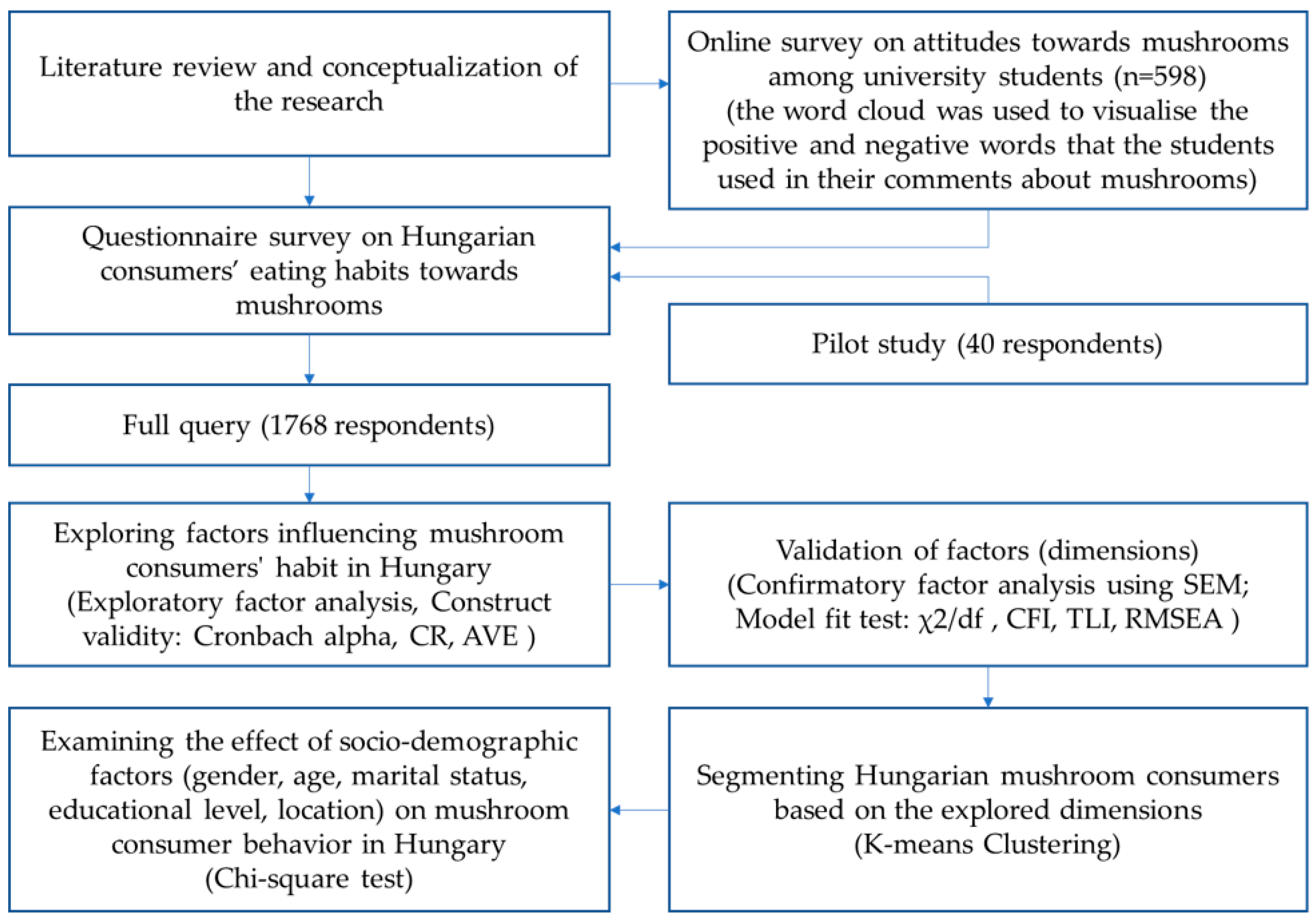
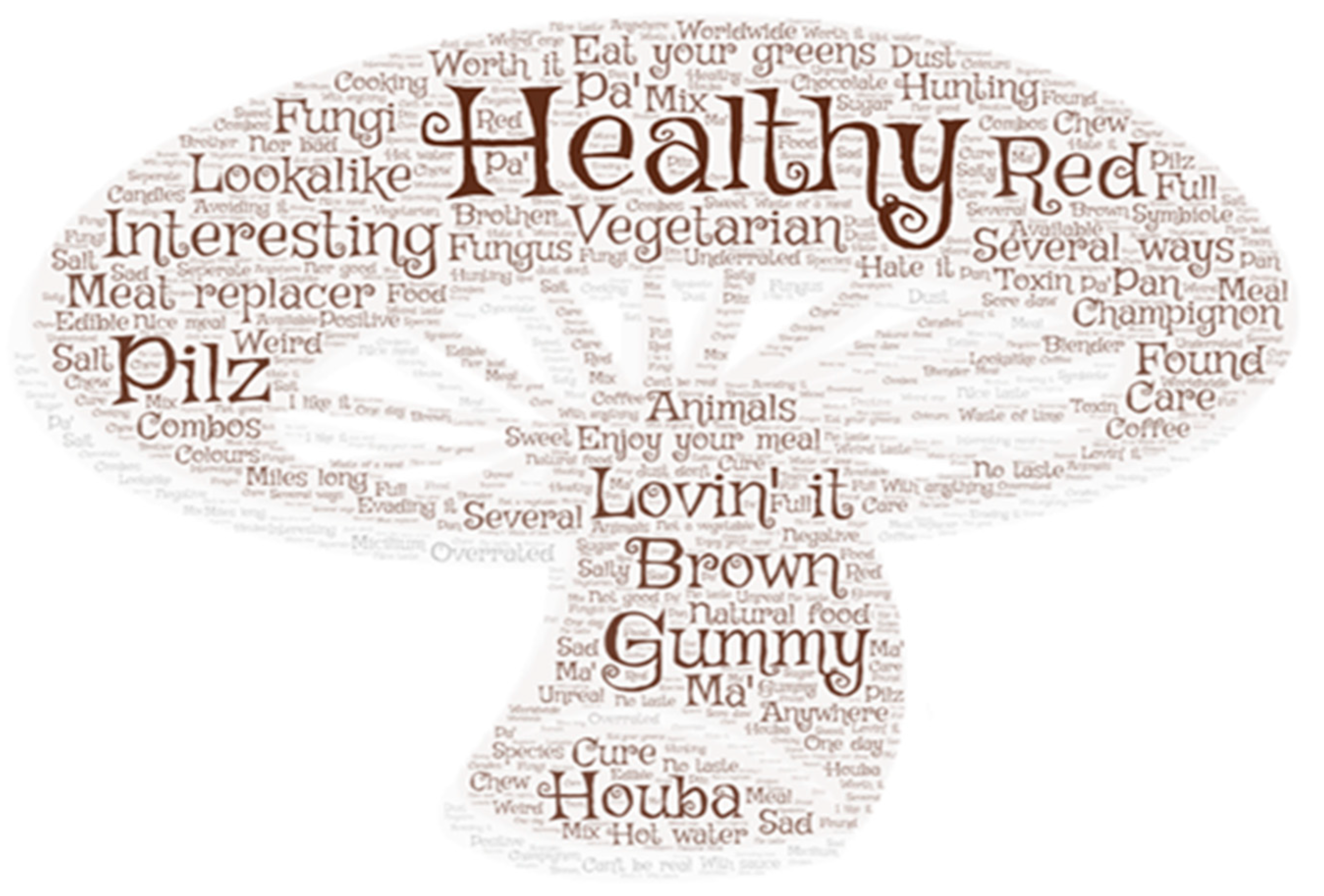
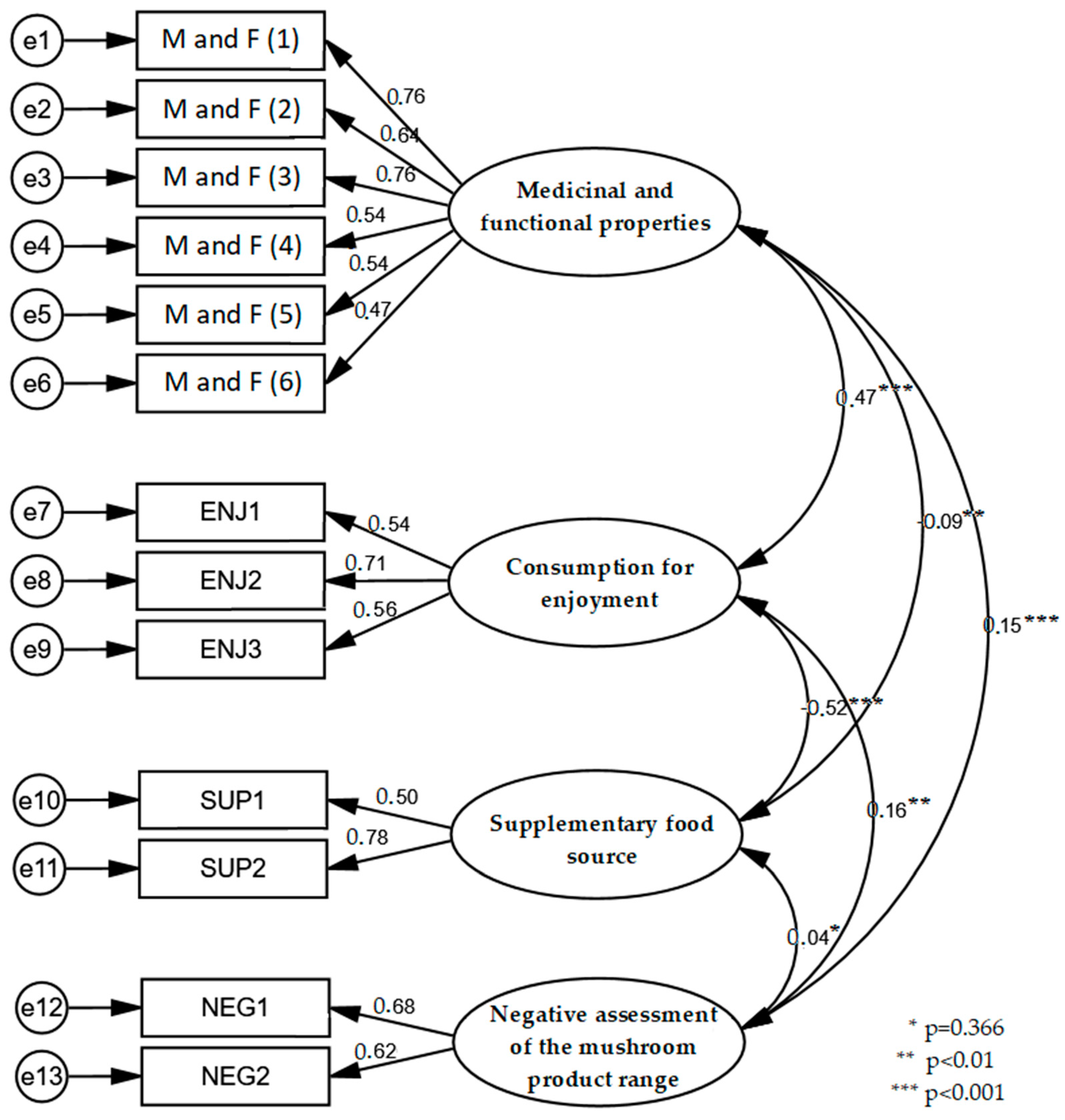
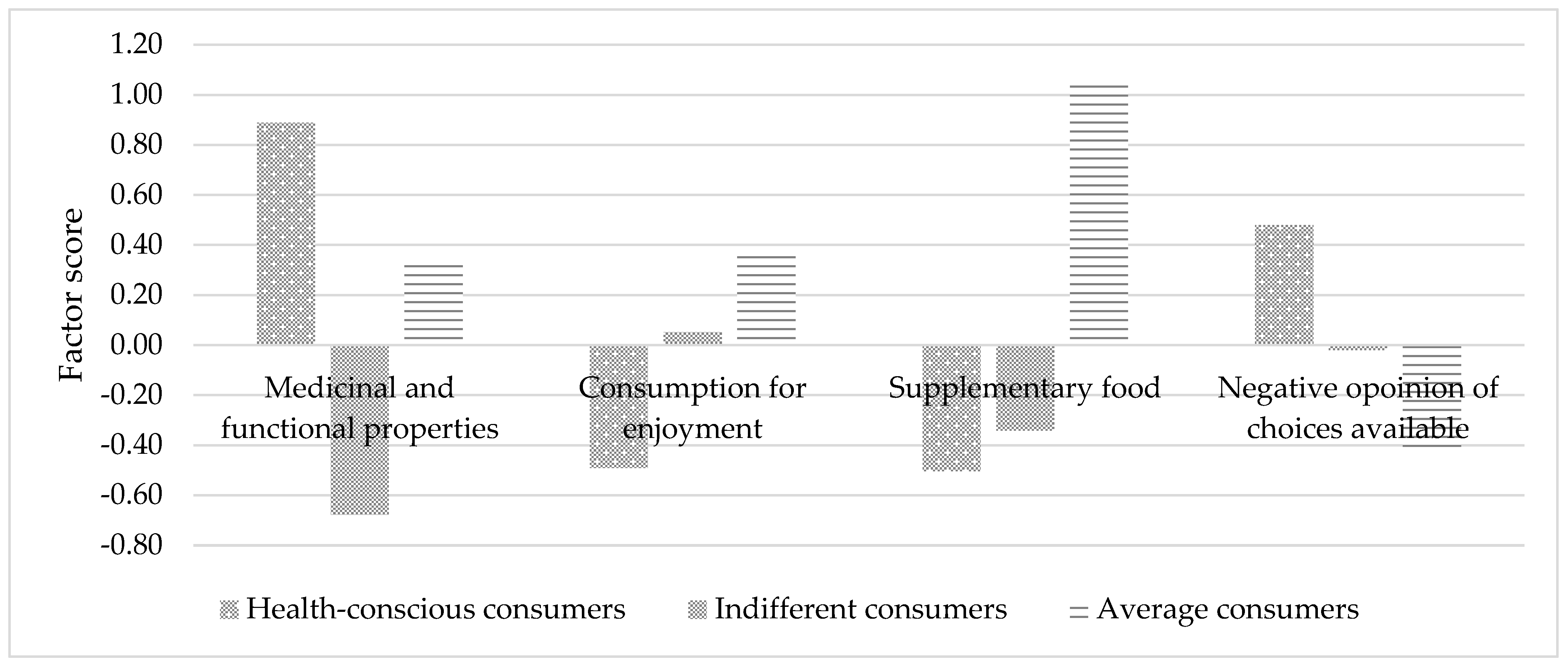

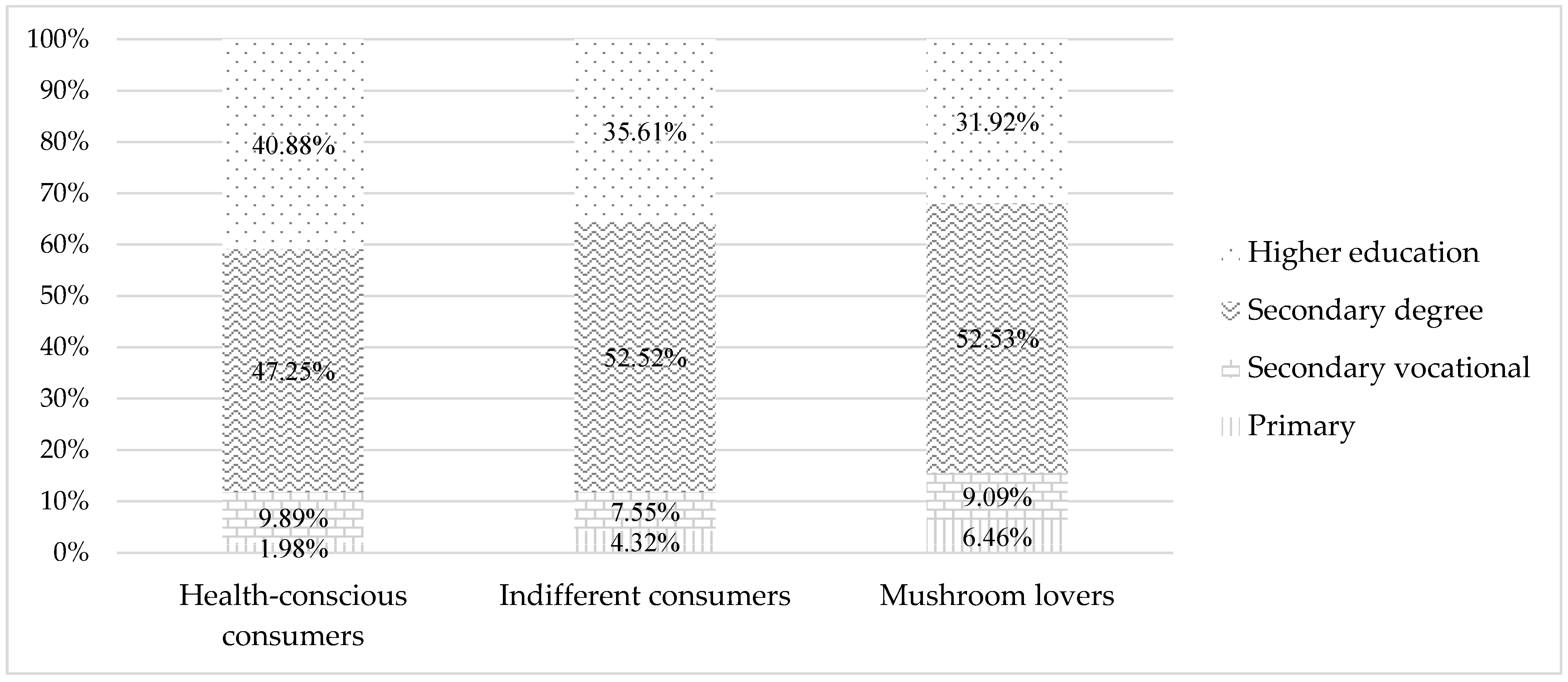
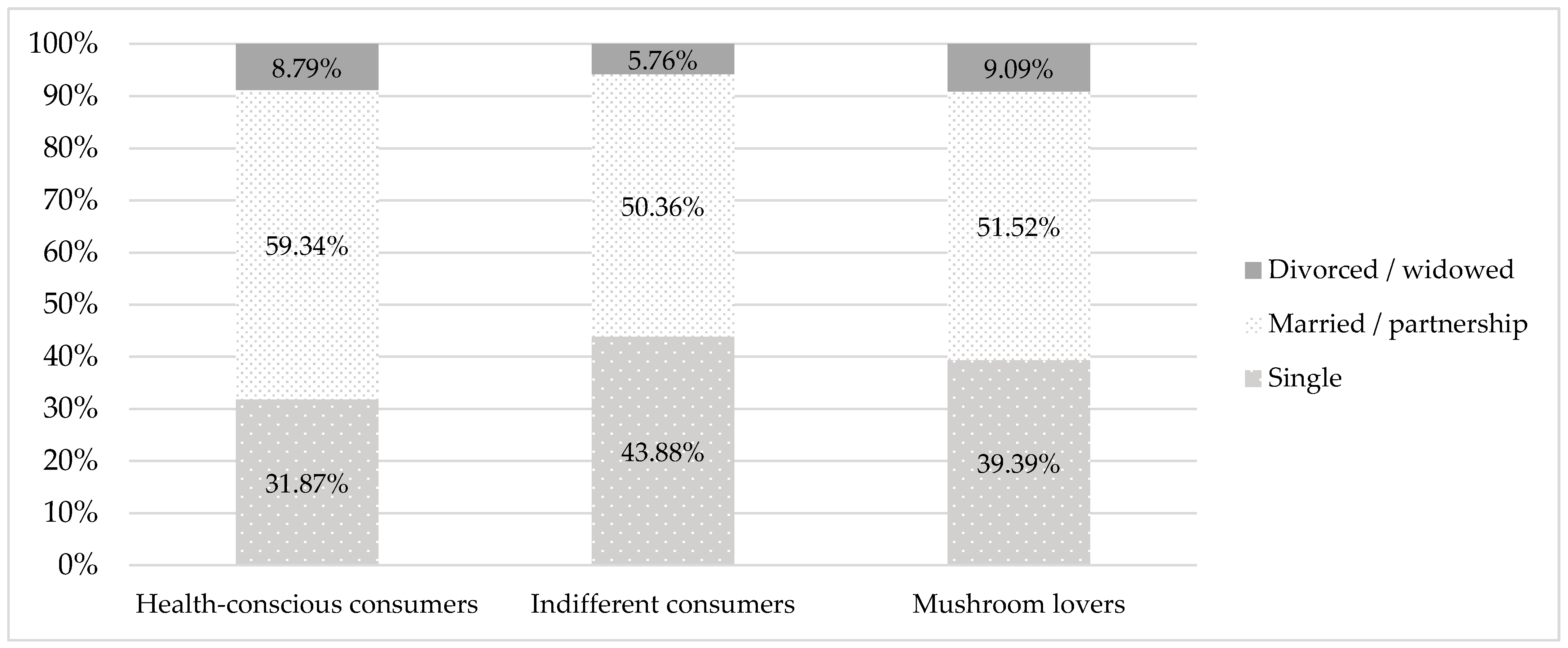
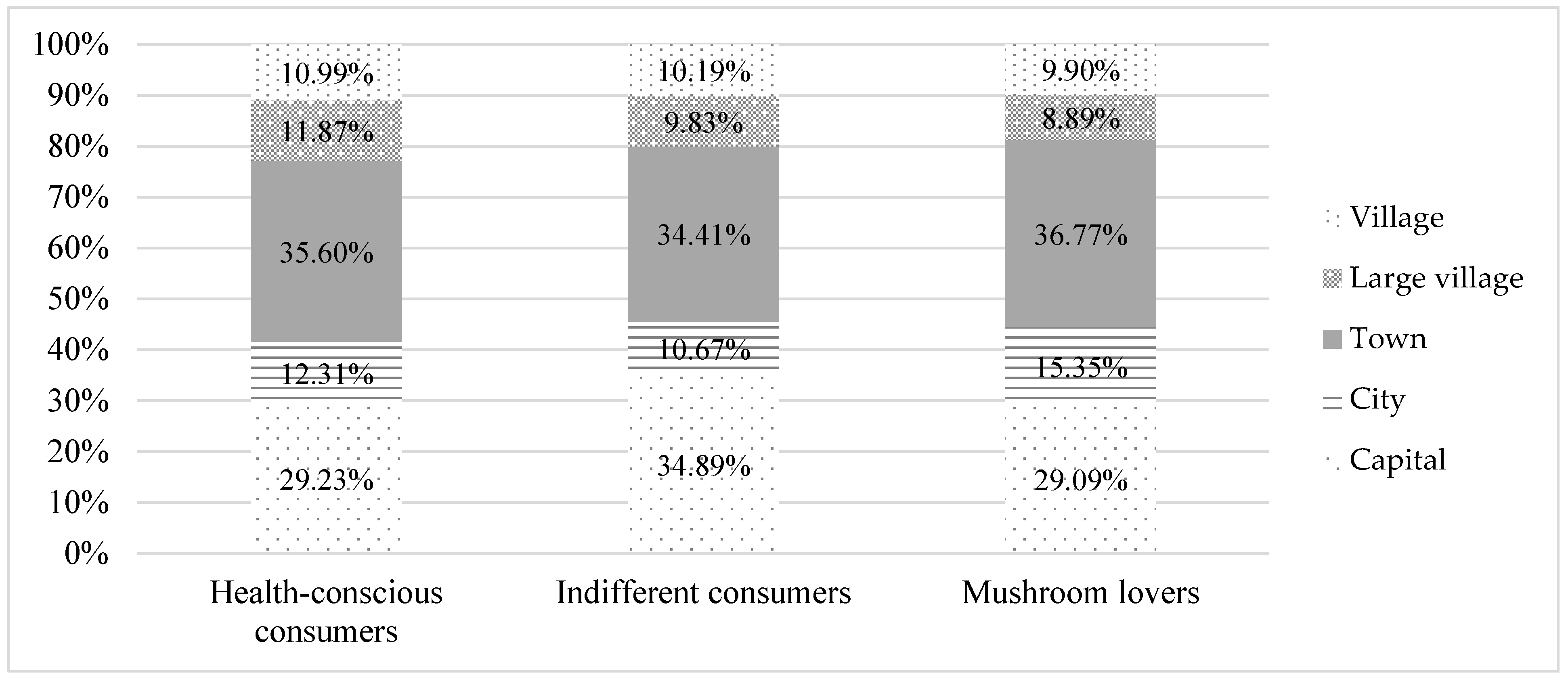
| Medicinal Effect | References |
|---|---|
| Tumors | Finimundy et al. (2018) [41]; Cerletti et al. (2021) [43] |
| Immune system | Mallard et al. (2019) [42]; Villares et al. (2012) [44] |
| Cardiovascular diseases | Lelley (2018) [20]; Rahman et al. (2015) [45], Genesan–Xu (2018) [46] |
| Inflammations | Berg–Lelley (2016) [47] |
| Digestion problems | Shang et al. (2013) [48]; Wong et al. (2013) [49]; Wang et al. (2018) [50]; Kumari (2020) [51] |
| Autoimmune deficiencies | Beelman et al. (2019) [52]; Muszyńska et al. (2018) [53] |
| Antibacterial and antiviral effects | Vetter (2010) [18] |
| Reducing blood glucose level | Calvo et al. 2016 [54]; Vitak et al. (2017) [55] |
| Skin care | Wu et al. 2016 [56]; Usman et al. (2021) [57] |
| Global Challenges | Functions | Major Publications | Underlying Concept |
|---|---|---|---|
| POLLUTION | Waste management | Gyenge et al. (2016) [65]; Gunady et al. (2012) [73]; Cunha Zied et al. (2020) [74]; Kumla et al. (2020) [75] | Mushroom production uses waste and by-products from various agricultural sectors. |
| Soil improvement | Klein 2020 [67] | Mushrooms accumulate toxins from the soil. | |
| LACK OF FOOD SUPPLIES | Food production | Royse et al. (2017) [13] | Mushrooms are healthful and safe sources of nutrition (low carbohydrate content, high protein and fibre content). |
| DEGRADATION OF THE QUALITY OF LIFE | Reduction in poverty | Imtiaj−Rahman (2008) [69]; Barmon et al. (2012) [70]; Bajpai et al. (2021) [71] | Mushroom production and collection of forest mushrooms provide regular jobs and income for populations with low levels of education. |
| Mycotherapy | Zhang et al. (2018) [76]; Glamoclija−Sokovic (2017) [77] | Mushrooms are used for medicinal purposes. |
| Dimensions (Factors and Constructs) | Short Description of Indicators | Literature Sources Related to Factors |
|---|---|---|
| Medical and functional properties | Consumption due to medical and functional reasons | Pender (1987) [78]; Wang et al. (2020) [79]; Papp-Bata−Szakály (2020) [80]; Ronteltap (2008, p. 91) [81] |
| Consumption of enjoyment | Consumption for tastes, aromas, special culinary delights | Steenkamp (1997, p. 144) [82]; Thomson−Crocker (2015, pp. 343–353) [83] |
| Supplementary food source | Consumption as a meat substitute or as ingredients for special meals | Pilgrim (1957, pp. 171–175) [84] |
| Negative assessment of the mushroom product range | Negative assessment of the choice of mushrooms and mushroom products | Almádi (2021) [85] |
| Variable | Category | Frequency | Percentage |
|---|---|---|---|
| Gender | Male | 749 | 42.0 |
| Female | 1036 | 58.0 | |
| Marital status | Single | 706 | 39.6 |
| Married | 946 | 53.0 | |
| Divorced/widowed | 133 | 7.5 | |
| Age | Under 20 | 193 | 10.8 |
| 20–30 years of age | 661 | 37.0 | |
| 31–40 years of age | 247 | 13.8 | |
| 41–50 years of age | 368 | 20.6 | |
| 51–60 years of age | 177 | 9.9 | |
| 61–70 years of age | 100 | 5.6 | |
| Over 70 | 39 | 2.2 | |
| Location | Capital | 568 | 31.8 |
| City | 221 | 12.4 | |
| Town | 632 | 35.4 | |
| Village | 180 | 10.1 | |
| Small village | 184 | 10.3 | |
| Education | Primary school | 77 | 4.3 |
| Vocational school | 153 | 8.6 | |
| Secondary school | 913 | 51.1 | |
| College/university | 642 | 36.0 |
| Construct | Measurement Item | Mean (SD) | Loadings | Cronbach’s Alpha | Composite Reliability (CR) | Average Variance Extracted (AVE) |
|---|---|---|---|---|---|---|
| Medicinal and functional properties | M and F (1) | 5.07 (1.53) | 0.758 | 0.786 | 0.890 | 0.553 |
| M and F (2) | 4.63 (1.49) | 0.735 | ||||
| M and F (3) | 5.20 (1.59) | 0.730 | ||||
| M and F (4) | 4.42 (1.37) | 0.650 | ||||
| M and F (5) | 5.22 (1.72) | 0.579 | ||||
| M and F (6) | 4.25 (1.45) | 0.557 | ||||
| Consumption for enjoyment | ENJ1 | 5.06 (1.92) | 0.759 | 0.545 | 0.805 | 0.556 |
| ENJ2 | 5.91 (1.67) | 0.646 | ||||
| ENJ3 | 4.94 (1.88) | 0.612 | ||||
| Supplementary food source | SUP1 | 2.77 (1.88) | 0.815 | 0.560 * | 0.865 | 0.641 |
| SUP2 | 2.33 (1.72) | 0.786 | ||||
| Negative assessment of the mushroom product range | NEG1 | 2.33 (1.72) | 0.798 | 0.526 * | 0.847 | 0.608 |
| NEG2 | 3.52 (1.73) | 0.762 |
Publisher’s Note: MDPI stays neutral with regard to jurisdictional claims in published maps and institutional affiliations. |
© 2021 by the authors. Licensee MDPI, Basel, Switzerland. This article is an open access article distributed under the terms and conditions of the Creative Commons Attribution (CC BY) license (https://creativecommons.org/licenses/by/4.0/).
Share and Cite
Bringye, B.; Fekete-Farkas, M.; Vinogradov, S. An Analysis of Mushroom Consumption in Hungary in the International Context. Agriculture 2021, 11, 677. https://doi.org/10.3390/agriculture11070677
Bringye B, Fekete-Farkas M, Vinogradov S. An Analysis of Mushroom Consumption in Hungary in the International Context. Agriculture. 2021; 11(7):677. https://doi.org/10.3390/agriculture11070677
Chicago/Turabian StyleBringye, Bernadett, Maria Fekete-Farkas, and Szergej Vinogradov. 2021. "An Analysis of Mushroom Consumption in Hungary in the International Context" Agriculture 11, no. 7: 677. https://doi.org/10.3390/agriculture11070677
APA StyleBringye, B., Fekete-Farkas, M., & Vinogradov, S. (2021). An Analysis of Mushroom Consumption in Hungary in the International Context. Agriculture, 11(7), 677. https://doi.org/10.3390/agriculture11070677







